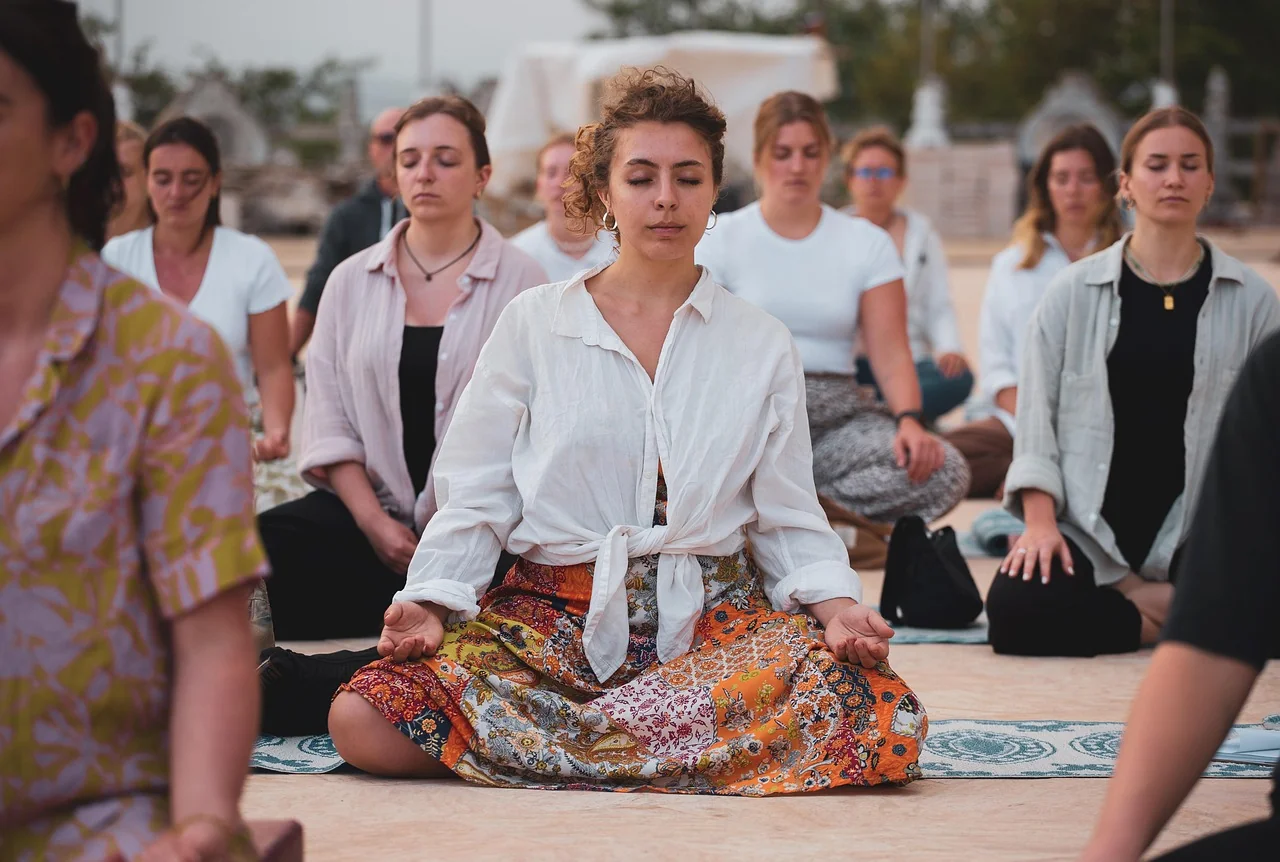Does your mind feel like a browser with too many tabs open? The constant ping of notifications, the pressure of deadlines, and the endless to-do list can leave you feeling perpetually overwhelmed. This state of chronic stress isn't just unpleasant; it can take a real toll on your mental and physical health. But what if you could train your brain to find calm amidst the chaos? The powerful, scientifically-backed answer lies in the practice of mindfulness. In fact, a growing body of research confirms that mindfulness reduces stress by fundamentally changing how your brain and body respond to pressure.
This article is your practical guide to understanding exactly how this works and, more importantly, how you can make it work for you. We'll dive into the fascinating science behind mindfulness meditation, explore simple yet powerful techniques like mindful breathing to lower cortisol levels, and outline the tangible benefits you can expect. Get ready to discover how to move from feeling reactive and drained to becoming grounded and resilient. Let's begin your journey toward a calmer, more present life.
The Science of Stress and How Mindfulness Interrupts the Cycle
To understand how mindfulness is such an effective tool, it's helpful to first understand the mechanics of stress. When you face a perceived threat—whether it's a looming deadline or a difficult conversation—your body's ancient survival mechanism, the "fight-or-flight" response, kicks in. Your amygdala, the brain's alarm system, signals the release of stress hormones like cortisol and adrenaline. Your heart rate speeds up, muscles tense, and breathing becomes shallow. This is fantastic for escaping a saber-toothed tiger, but when triggered constantly by modern-day worries, it becomes chronic stress. High cortisol levels over long periods can disrupt almost all your body's processes, increasing your risk for anxiety, depression, digestive issues, and heart disease.
Mindfulness meditation acts as a direct antidote to this cycle. It doesn't eliminate stress; it changes your relationship with it. Neuroscientific studies using fMRI scans show that consistent mindfulness practice can physically change your brain. It strengthens the prefrontal cortex, the area responsible for rational thought and emotional regulation, while calming down the reactive amygdala. Essentially, you're building a bigger, stronger brake pedal for your stress response.
When you practice being present moment to moment, you activate the parasympathetic nervous system, your body's "rest-and-digest" mode. This is the physiological opposite of fight-or-flight. Your heart rate slows, your breath deepens, and your body stops pumping out high levels of cortisol. Research has consistently linked mindfulness practice with measurable reductions in cortisol levels, providing a concrete biological explanation for the feeling of calm that follows a session. By observing your stress without immediately reacting to it, you create a crucial pause—a space where you can choose a more skillful response instead of being hijacked by your emotions.
Core Mindfulness Techniques for Immediate Stress Reduction
Understanding the theory is one thing, but the true power of mindfulness is in its practice. You don't need a silent retreat or hours of free time to start experiencing its stress-busting effects. These foundational mindfulness techniques are designed to be woven into the fabric of your daily life, offering you a lifeline when you feel overwhelmed.
Anchor in the Present with Mindful Breathing
Your breath is the most portable anchor you have. It’s always with you, and tuning into it is the fastest way to drop out of a racing mind and into your body. This practice is the cornerstone of stress reduction.
- Find Your Posture: Sit comfortably in a chair with your feet flat on the floor, or lie down. Close your eyes or soften your gaze.
- Tune In: Bring your attention to the physical sensation of breathing. Notice the cool air entering your nostrils and the slightly warmer air leaving. Feel your chest and belly rise and fall.
- Follow and Return: Your mind will wander. This is not a failure; it's the entire practice. The moment you realize you’ve been caught in a thought, gently and without judgment, guide your attention back to the sensation of the next breath. Start with just three to five minutes a day. For more structured guidance, our guide on quick mindfulness meditation is a great place to start.
The Body Scan for Releasing Physical Tension
Stress doesn't just live in your mind; it manifests as physical tension in your body—tight shoulders, a clenched jaw, a knotted stomach. The body scan is a powerful technique for discovering and releasing this stored stress.
Begin by bringing your awareness to the toes of your left foot. Notice any sensations there—tingling, warmth, pressure, or even numbness. Without trying to change anything, simply observe. On your next exhale, imagine releasing any tension from that area. Slowly, methodically, move your attention up through your left foot, ankle, calf, and knee, repeating the process. Continue this journey through your entire body, part by part, all the way to the top of your head. This practice trains you to inhabit your body fully and intercept the physical buildup of stress.
Observing Thoughts Without Judgment
A major source of our stress is getting tangled in our thoughts, treating every worry as a fact. This technique teaches you to become a witness to your mental activity, creating space between you and your stressors. This skill is deeply connected to the principle of mindfulness and letting go.
Sit quietly and imagine your mind as a vast sky. Your thoughts, feelings, and sensations are like clouds passing through. Some are dark and stormy (anxious thoughts), some are light and fluffy (happy memories). Your job is not to stop the clouds or chase them away. It is simply to sit as the sky, watching them come and go without getting attached. When you find yourself caught in a cloud—lost in a stressful story about the future—gently acknowledge, "Ah, there's a worrying thought," and return your awareness to the spacious sky. This mental shift from reactor to observer is profoundly liberating and a key component of anxiety relief.
The Tangible Benefits: How a Mindful Life Lowers Your Stress
The benefits of mindfulness extend far beyond the few minutes you spend in formal practice. When cultivated consistently, it begins to rewire your default responses to life's challenges, leading to tangible improvements in your overall well-being and quality of life.
Improved Emotional Regulation: Mindfulness gives you the tools to notice an angry or anxious reaction as it begins to bubble up. Instead of being swept away by the emotional wave, you can pause, acknowledge the feeling, and choose how to respond. This leads to less conflict, better relationships, and a greater sense of self-control.
Enhanced Focus and Clarity: Chronic stress scatters our attention. By training your mind to return to an anchor like the breath, you are strengthening your "attention muscle." This makes it easier to concentrate on tasks, filter out distractions, and think more clearly, which directly reduces the stress of feeling mentally overwhelmed and unproductive.
Better Sleep Quality: Racing thoughts are a primary culprit of insomnia. A brief mindfulness practice before bed, such as a body scan or mindful breathing, helps calm the nervous system and quiet the mind. By learning to observe thoughts without engaging with them, you can break the cycle of nighttime worry and drift into more restful, restorative sleep.
Increased Resilience: Life is inherently unpredictable and challenging. Mindfulness doesn't create a bubble of perpetual calm, but it does build resilience—the ability to bounce back from difficulties. By teaching you to meet unpleasant experiences with curiosity and compassion rather than resistance, you build a robust inner capacity to navigate stress, loss, and change with more grace and less suffering. This is perhaps one of the most profound gifts of a sustained practice.
Building Your Sustainable Mindfulness Habit
The most perfect technique is useless if you don't practice it. The biggest hurdle for most people is the belief that they don't have the time or that they're "not doing it right." The key is to release all-or-nothing thinking and build a sustainable habit.
Start small is the golden rule. Committing to 45 minutes a day is a recipe for burnout. Instead, aim for just five to ten minutes each day. Consistency is infinitely more important than duration. It's better to practice for five minutes every day than for an hour once a month. Link your practice to an existing habit to make it stick. Try three minutes of mindful breathing after you brush your teeth in the morning, or a brief body scan right after you get into bed.
Let go of the goal of "clearing your mind." A busy mind is not a problem to be solved; it is the very condition for the practice. Every time you notice your mind has wandered and you gently bring it back, you are doing the rep that strengthens your brain. That is the practice. It is not a sign of failure. For more support, our compilation of mindfulness meditation tips can help both beginners and seasoned practitioners refine their approach.
Finally, practice mindfulness informally throughout your day. You don't have to be on a cushion to be mindful. Try to bring present-moment awareness to routine activities.
- When you shower, feel the water on your skin and notice the scent of the soap.
- When you drink your morning coffee, savor its smell, taste, and warmth.
- When you walk, feel the contact of your feet with the ground.
These micro-moments of awareness are just as valuable as formal meditation. They are how you weave the thread of mindfulness into the fabric of your life, transforming your relationship with stress not just during your practice, but in every moment that follows.
In summary, the practice of mindfulness offers a powerful and accessible pathway to significantly reduce stress. By cultivating a non-judgmental awareness of the present moment, we can interrupt the cycle of anxious thoughts and reactive emotions that fuel our stress response. The techniques explored—from focused breathing and body scans to integrating mindful moments into daily routines—provide practical tools to manage life's pressures. The evidence is clear: consistently engaging with these practices rewires our neural pathways, lowers cortisol levels, and enhances emotional resilience. This is not about eliminating stress entirely, but about changing our relationship with it, empowering us to respond with greater clarity and calm. The journey toward a less stressed life begins with a single, conscious breath. We encourage you to choose one technique and commit to it for a week, discovering for yourself the profound sense of balance and control that mindfulness can bring to your everyday experience.


